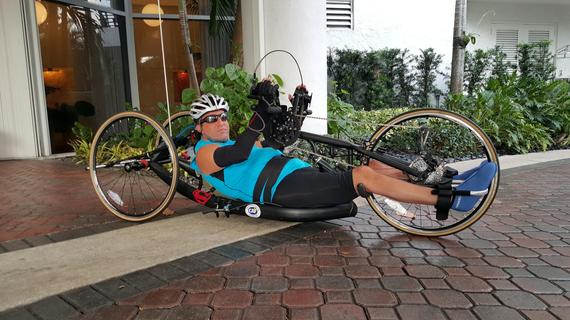On January 2, 1988, Alan T. Brown was on vacation in Martinique. He was just about to turn 21. The deep blue ocean beckoned and he dove into the surf.
The next thing he knew the undertow pulled his legs out from under him and flipped him upside down onto the hard sand. He hit the ocean's floor head-first then heard a snap.
Brown was under water for 3 to 4 minutes, face down and unable to breathe. He knew something was terribly wrong. "I was in the prime of my life and now immobile...nothing moved," he recalls.
Here was a man who thrived playing ice hockey, running in New York's Central Park, throwing baseballs -- suddenly unable to walk. "In a split second my life changed forever," he says. "A quadriplegic by age 21, confined to a wheelchair. How would I continue?"
Not only did Brown continue. He thrived. Feeling driven, he built a successful marketing career and founded a public relations firm in Hollywood, Florida. Brown became an avid skydiver, scuba diver and swimmer. And he has two sons, Max and Sam. "My sons have only known me in a wheelchair and I hope that they will be kind and compassionate to others who are confined to wheelchairs," says Brown. "I may be confined to a wheelchair, but I am a whole person."
Just a few years after his accident Brown completed two New York City marathons. "When I did the race in 1990 and 1991, they started us so early that none of the streets we started on in Brooklyn were closed off," he says. In 1991, just when he hit mile 23 ½, race officials physically stopped him so he wouldn't get in the way of the lead runners. "It was freezing cold, and my body was shot," he recalls. "I had to wait about eight minutes for them to go by before they let me go again. When doing a marathon the last few miles are done on adrenaline and they totally threw me off when they stopped me."
In fact, the incident inspired Brown to work with his brother, lawyer Daniel Brown, to challenge the marathon's rules by filing a class-action lawsuit to make sure there was equality for all wheelchair athletes. "Leveraging the ADA (Americans with Disabilities Act) Alan worked with his brother...and won a landmark case that resulted in a more accessible course and equal treatment for athletes living with disabilities," says Peter Wilderotter, CEO of the Christopher & Dana Reeve Foundation. "Alan Brown has sustained blisters, shoulder injuries, and has modified his entire life to tackle the marathon. His team name, Never Say Never, is a testament to his unwavering hope that cures for spinal cord injury are not only possible, they are inevitable."
On Sunday, November 1, 25 years after his last marathon, Brown joined 64 athletes as part of Team Reeve to race in the New York City Marathon for the Christopher & Dana Reeve Foundation. Team Reeve hopes to bring awareness that there are therapies and research advances that can now dramatically improve and save lives.
"Although discovering cures for spinal cord injury might indeed be a marathon, breakthroughs like epidural stimulation will help us get to the finish line," says Wilderotter. "At the end of the day, Team Reeve is a community -- a movement to rally together and deliver on Christopher Reeve's dream."
The Team Reeve hand cyclists (They use their arms rather than their legs to power three-wheeled cycles known as a hand cycle.) embody the spirit of Christopher Reeve who believed "nothing is impossible." Just ask Dennis McGorty, a former world-class collegiate decathlete and avid cyclist who was injured in a 2013 cycling accident after he was struck by a truck.
McGorty signed up for the marathon to get back into the sport he loved and help raise awareness for spinal cord research. "We're all capable of so much more than we know," he says. "Too often it takes being pushed to the limits before we realize it. But that drive and ability lives within all of us."
(Photo used with permission.)

